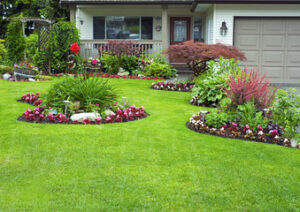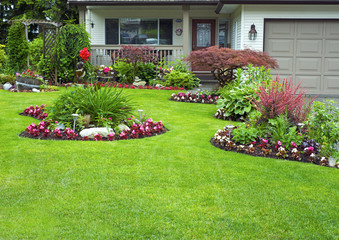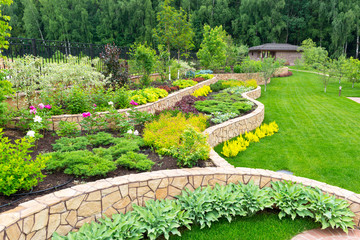Greensboro Landscaping involves designing and modifying outdoor spaces to improve aesthetics, utility and sustainability. Landscape elements like trees, shrubs, flowers, and grass provide color, texture and seasonal variety, while hardscape features like patios, flagstone walkways, custom concrete work, retaining walls, and water features define space and support outdoor living.
Soil is also an important component to consider. Sandy soil drains quickly and doesn’t hold plant nutrients well, while heavy clay soil can be difficult to work with.
Sod and turf are both options for lush, green lawns. But which is right for you? Sod offers a quick solution that eliminates the hassle of seeding and waiting for new grass to grow. However, sod has higher initial costs than seed and requires more maintenance.
Whether you’re starting from scratch or revitalizing your existing landscape, sod is a great option for those who want a quick return on their investment. It instantly adds beauty and curb appeal to your property, making it more appealing to visitors.
It also supports local ecosystems by providing a habitat for insects, birds, and small animals. And it absorbs carbon dioxide, reducing the overall carbon footprint of your home or business. However, the water and chemicals used to maintain sod lawns can have a negative impact on the environment.
Sod is a popular choice for many residential and commercial properties. It offers the look and feel of a traditional lawn, with the benefits of a natural, healthy environment. Sod helps to protect the interior of your home or office from muddy feet tracks and provides a soft surface for children and pets to play on. It also reduces erosion on sloped areas and enables better control of stormwater runoff.
There are several types of sod available in Orlando, each with their own perks and challenges. St. Augustine Floratam and Zoysia Palisades are two of the most common types of sod in the area. Both require full sun to thrive and can become sparse in shade. But if you want a beautiful, dense, and vibrant sod lawn, they’re worth the effort!
Cool-season sods like tall fescue (Festuca spp.) are good choices for northern climates. They hold up well in the cold, but go dormant when summer temperatures hit 90 degrees Fahrenheit. These sods are typically harvested in square or rectangular slabs or in large rolls of up to 5 feet in length.
The most important factor in choosing sod is finding a supplier that can deliver quality grass that’s locally grown. Woerner Turfgrass farmers use superior growing and soil practices to produce a premium sod that’s ideal for homes, businesses, and sports stadiums.
Installation
Landscaping involves the installation of outdoor features that enhance a property’s aesthetics and functionality. It includes a wide range of services like lawn care, planting trees and flowers, hardscaping, irrigation, and lighting. It also encompasses design planning and terrain assessment. Professional landscapers often use these services to help homeowners achieve their dream yard.
The most common landscaping feature is the lawn. Grass is easy to maintain and can instantly transform a yard’s appearance. It’s important to choose the right type of grass for your climate and soil conditions. Some types of grass require regular watering, mowing, and fertilization to keep them healthy and vibrant.
Another popular landscaping feature is the garden bed, which is a raised area where you can plant flowers and vegetables. It’s important to choose the right plants for your garden beds, as well as the proper size and location. Garden beds should be properly planted to ensure that they grow and thrive over time.
Landscapers can also add a variety of outdoor structures to your yard, such as patios, walkways, and retaining walls. These structures create visual interest and define the space. They can also be used for entertaining and relaxing, making them a great addition to any home.
A good landscaper will take into consideration the way your family uses its yard. They’ll be able to recommend the best plants and structures for your needs. For example, they can install a fire pit to create a warm and inviting place for gatherings. They can also add a water feature to introduce soothing sounds and movement to your yard.
While most people want their homes to have a natural look, it’s important to strike a balance between nature and the house. This can be done by choosing the right combination of colors, textures, and shapes for your landscape. It’s also a good idea to consider the amount of light your yard gets throughout the day. If you have a lot of sunlight, your yard will be much more vibrant than one that’s shaded by trees and shrubs.
A well-planned landscaping project will save you a lot of time and money in the long run. It will also increase the value of your home or business.
Maintenance
A well-maintained landscape can enhance the beauty of your property, increase its value, and create a relaxing, comfortable outdoor space for entertainment and enjoyment. The key to successful landscaping is regular maintenance, which includes proper watering, fertilization, pruning, and pest control. Additionally, it is important to select plants and trees that are suited to your climate and soil conditions. This will help them thrive and reduce the need for excessive watering and pruning. Finally, it is important to plan for the long-term, and consider the effects of seasonal changes on your landscape.
Landscaping is the art of designing, constructing, and maintaining outdoor spaces. It includes adding plants and altering terrain to achieve a desired aesthetic appearance, as well as creating functional outdoor areas.
Unlike gardening, which is focused on growing plants for personal pleasure and sustenance, landscaping has a more creative focus. It also involves using large-scale design elements such as water features, rock gardens, and gazebos. These features can add visual interest and create a sense of tranquility and mystery.
In addition to plants, trees, and grass, a landscaping design may incorporate hardscape elements such as pathways, patios, and decks. Water features like ponds and fountains can add a soothing element to your garden, while statues and ornamental grasses can provide texture and color. Landscapers also work with other types of materials to create a unique and appealing environment, such as mulches and organic composts.
While planting and grading are the primary components of landscaping, it is important to maintain your lawn for optimal health and beauty. Maintenance activities include mowing, trimming, and edging to maintain a neat appearance; soil testing and analysis to determine the correct type of fertilizer; and routine inspections and adjustments to your irrigation system. Weed prevention is also essential, and should be done regularly using pre- and post-emergent herbicides.
Having an established garden will make it easier to care for in the future. Establishing a regular schedule for maintenance tasks will prevent them from becoming overwhelming, and it is helpful to develop a list of recurring tasks that should be completed each month.
Pricing
Landscapers use a variety of materials to transform outdoor spaces into inviting and functional areas for homeowners. Whether a simple lawn seeding, tree trimming or full yard makeover, landscaping can be a significant investment that raises property values and adds value to homes. It also creates comfortable and relaxing outdoor living spaces for families and friends. It is important for homeowners to understand what goes into the cost of landscaping services and how the price varies from project to project.
The size and complexity of a landscaping project directly impacts costs, with higher-end projects typically having higher overall prices than smaller or more straightforward jobs. Design choices, the type of landscaping desired and specific material selections (like wood or natural stone) can significantly impact final landscaping costs. Additionally, labor rates play a role in pricing. Landscaping contractors often charge for the time and expertise involved in completing the job, resulting in hourly rates that can add up quickly.
Other factors that influence landscapers’ pricing are regional prices, the difficulty of the terrain and environmental concerns. Rugged terrain, for example, may necessitate the need for landscape grading, which can add up quickly. Other environmental concerns, like water runoff and drainage issues, could require the installation of retaining walls or other features to help mitigate these problems.
Creating a unified, harmonious arrangement of elements is also an important aspect of landscaping. This may include the placement of trees, shrubs and flowers, as well as water and garden ornamentation. Water features such as ponds, fountains and waterfalls add interest and can also provide a tranquil atmosphere. Ornaments such as lanterns, pagodas and statues can add intrigue, contrast and even spiritual significance to a garden.
Finally, it is important to consider how the landscape will be used. For example, if a homeowner wants to entertain guests, they might want to install an outdoor kitchen or fire pit. It is also important to consider the amount of sunlight that a particular area receives, as this can greatly affect how and when the space is used. This will impact what types of plants and flowers are chosen, as they should take into consideration the amount of sun or shade the area gets and how it will change throughout the day.


